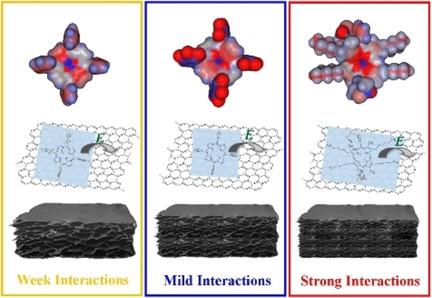当前位置:
X-MOL 学术
›
Chemistryopen
›
论文详情
Our official English website, www.x-mol.net, welcomes your
feedback! (Note: you will need to create a separate account there.)
Directed Molecular Stacking for Engineered Fluorescent Three-Dimensional Reduced Graphene Oxide and Coronene Frameworks.
ChemistryOpen ( IF 2.5 ) Pub Date : 2019-12-04 , DOI: 10.1002/open.201900310 Boyang Mao 1, 2, 3 , Fernando Cortezon-Tamarit 1 , Haobo Ge 1 , Navaratnarajah Kuganathan 4 , Vincenzo Mirabello 1 , Francisco J Palomares 5 , Gabriele Kociok-Köhn 1 , Stanley W Botchway 6 , David G Calatayud 7 , Sofia I Pascu 1
ChemistryOpen ( IF 2.5 ) Pub Date : 2019-12-04 , DOI: 10.1002/open.201900310 Boyang Mao 1, 2, 3 , Fernando Cortezon-Tamarit 1 , Haobo Ge 1 , Navaratnarajah Kuganathan 4 , Vincenzo Mirabello 1 , Francisco J Palomares 5 , Gabriele Kociok-Köhn 1 , Stanley W Botchway 6 , David G Calatayud 7 , Sofia I Pascu 1
Affiliation

|
Three‐dimensional fluorescent graphene frameworks with controlled porous morphologies are of significant importance for practical applications reliant on controlled structural and electronic properties, such as organic electronics and photochemistry. Here we report a synthetically accessible approach concerning directed aromatic stacking interactions to give rise to new fluorogenic 3D frameworks with tuneable porosities achieved through molecular variations. The binding interactions between the graphene‐like domains present in the in situ‐formed reduced graphene oxide (rGO) with functional porphyrin molecules lead to new hybrids via an unprecedented solvothermal reaction. Functional free‐base porphyrins featuring perfluorinated aryl groups or hexyl chains at their meso‐ and β‐positions were employed in turn to act as directing entities for the assembly of new graphene‐based and foam‐like frameworks and of their corresponding coronene‐based hybrids. Investigations in the dispersed phase and in thin‐film by XPS, SEM and FLIM shed light onto the nature of the aromatic stacking within functional rGO frameworks (denoted rGOFs) which was then modelled semi‐empirically and by DFT calculations. The pore sizes of the new emerging reduced graphene oxide hybrids are tuneable at the molecular level and mediated by the bonding forces with the functional porphyrins acting as the “molecular glue”. Single crystal X‐ray crystallography described the stacking of a perfluorinated porphyrin with coronene, which can be employed as a molecular model for understanding the local aromatic stacking order and charge transfer interactions within these rGOFs for the first time. This opens up a new route to controllable 3D framework morphologies and pore size from the Ångstrom to the micrometre scale. Theoretical modelling showed that the porosity of these materials is mainly due to the controlled inter‐planar distance between the rGO, coronene or graphene sheets. The host‐guest chemistry involves the porphyrins acting as guests held through π‐π stacking, as demonstrated by XPS. The objective of this study is also to shed light into the fundamental localised electronic and energy transfer properties in these new molecularly engineered porous and fluorogenic architectures, aiming in turn to understand how functional porphyrins may exert stacking control over the notoriously disordered local structure present in porous reduced graphene oxide fragments. By tuning the porosity and the distance between the graphene sheets using aromatic stacking with porphyrins, it is also possible to tune the electronic structure of the final nanohybrid material, as indicated by FLIM experiments on thin films. Such nanohybrids with highly controlled pores dimensions and morphologies open the way to new design and assembly of storage devices and applications incorporating π‐conjugated molecules and materials and their π‐stacks may be relevant towards selective separation membranes, water purification and biosensing applications.
中文翻译:

用于工程荧光三维还原氧化石墨烯和晕苯框架的定向分子堆叠。
具有受控多孔形态的三维荧光石墨烯框架对于依赖受控结构和电子特性的实际应用(例如有机电子学和光化学)具有重要意义。在这里,我们报告了一种关于定向芳香堆积相互作用的合成方法,以产生新的荧光 3D 框架,并通过分子变化实现可调节的孔隙率。原位形成的还原氧化石墨烯(rGO)中存在的类石墨烯结构域与功能性卟啉分子之间的结合相互作用,通过前所未有的溶剂热反应产生新的杂化物。在其内消旋和β位置具有全氟化芳基或己基链的功能性游离碱卟啉反过来被用作组装新型石墨烯基和泡沫状框架及其相应的晕苯基杂化物的指导实体。通过 XPS、SEM 和 FLIM 对分散相和薄膜的研究揭示了功能性 rGO 框架(表示为 rGOF)内芳香族堆积的性质,然后通过半经验和 DFT 计算对其进行建模。新兴的还原氧化石墨烯杂化物的孔径可在分子水平上调节,并通过与充当“分子胶”的功能性卟啉的键合力来调节。单晶 X 射线晶体学描述了全氟化卟啉与晕苯的堆叠,这可以用作首次了解这些 rGOF 内局部芳香堆叠顺序和电荷转移相互作用的分子模型。 这开辟了一条从埃级到微米级可控3D框架形态和孔径的新途径。理论模型表明,这些材料的孔隙率主要归因于 rGO、晕苯或石墨烯片之间受控的晶面距离。正如 XPS 所证明的,主客体化学涉及卟啉通过 π-π 堆积充当客体。这项研究的目的还在于揭示这些新的分子工程多孔和荧光结构中基本的局域电子和能量转移特性,进而了解功能性卟啉如何对多孔中存在的臭名昭著的无序局部结构施加堆叠控制还原的氧化石墨烯碎片。通过使用卟啉芳香堆积来调节石墨烯片之间的孔隙率和距离,还可以调节最终纳米混合材料的电子结构,如薄膜上的 FLIM 实验所示。这种具有高度控制的孔隙尺寸和形态的纳米杂化物为存储设备的新设计和组装以及包含π共轭分子和材料的应用开辟了道路,它们的π堆叠可能与选择性分离膜、水净化和生物传感应用相关。
更新日期:2019-12-04
中文翻译:

用于工程荧光三维还原氧化石墨烯和晕苯框架的定向分子堆叠。
具有受控多孔形态的三维荧光石墨烯框架对于依赖受控结构和电子特性的实际应用(例如有机电子学和光化学)具有重要意义。在这里,我们报告了一种关于定向芳香堆积相互作用的合成方法,以产生新的荧光 3D 框架,并通过分子变化实现可调节的孔隙率。原位形成的还原氧化石墨烯(rGO)中存在的类石墨烯结构域与功能性卟啉分子之间的结合相互作用,通过前所未有的溶剂热反应产生新的杂化物。在其内消旋和β位置具有全氟化芳基或己基链的功能性游离碱卟啉反过来被用作组装新型石墨烯基和泡沫状框架及其相应的晕苯基杂化物的指导实体。通过 XPS、SEM 和 FLIM 对分散相和薄膜的研究揭示了功能性 rGO 框架(表示为 rGOF)内芳香族堆积的性质,然后通过半经验和 DFT 计算对其进行建模。新兴的还原氧化石墨烯杂化物的孔径可在分子水平上调节,并通过与充当“分子胶”的功能性卟啉的键合力来调节。单晶 X 射线晶体学描述了全氟化卟啉与晕苯的堆叠,这可以用作首次了解这些 rGOF 内局部芳香堆叠顺序和电荷转移相互作用的分子模型。 这开辟了一条从埃级到微米级可控3D框架形态和孔径的新途径。理论模型表明,这些材料的孔隙率主要归因于 rGO、晕苯或石墨烯片之间受控的晶面距离。正如 XPS 所证明的,主客体化学涉及卟啉通过 π-π 堆积充当客体。这项研究的目的还在于揭示这些新的分子工程多孔和荧光结构中基本的局域电子和能量转移特性,进而了解功能性卟啉如何对多孔中存在的臭名昭著的无序局部结构施加堆叠控制还原的氧化石墨烯碎片。通过使用卟啉芳香堆积来调节石墨烯片之间的孔隙率和距离,还可以调节最终纳米混合材料的电子结构,如薄膜上的 FLIM 实验所示。这种具有高度控制的孔隙尺寸和形态的纳米杂化物为存储设备的新设计和组装以及包含π共轭分子和材料的应用开辟了道路,它们的π堆叠可能与选择性分离膜、水净化和生物传感应用相关。











































 京公网安备 11010802027423号
京公网安备 11010802027423号